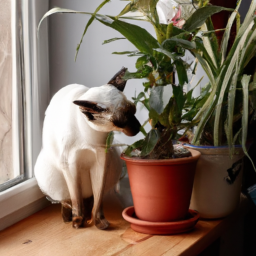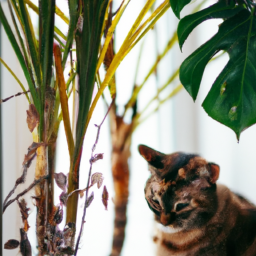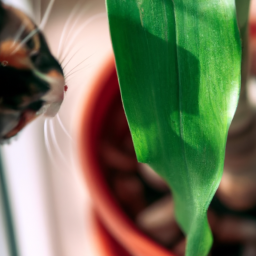
Are you a cat owner looking to spruce up your living space with some indoor plants? While adding greenery to your home can be a great way to bring the outdoors in, it’s important to be mindful of which plants you choose, especially if you have feline friends roaming around. In this blog post, we’ll be discussing indoor plants poisonous to cats and how to keep your furry companions safe while still enjoying the benefits of having plants in your home. So, let’s dive in and explore some common houseplants that can be harmful to our beloved pets.
Common Indoor Plants Toxic to Cats
Introduction
Indoor plants can add a touch of nature and beauty to your home, but for cat owners, it’s important to be aware of which plants can be toxic to our feline friends. Cats are curious creatures and may nibble on plants out of boredom or curiosity, so it’s crucial to know which plants to avoid having in your home if you have a cat. In this guide, we will discuss some common indoor plants that are toxic to cats and the symptoms of poisoning to look out for.
Types of Toxic Indoor Plants
There are several common indoor plants that are toxic to cats, including lilies, philodendron, and pothos. Lilies, in particular, are extremely toxic to cats and can cause kidney failure even in small amounts. Philodendron and pothos are also dangerous for cats and can cause symptoms such as vomiting, diarrhea, and difficulty breathing. Other toxic plants to be aware of include aloe vera, jade plants, and peace lilies.
If you have any of these plants in your home, it’s important to either keep them out of reach of your cat or consider getting rid of them altogether. Cats are known for their agility and ability to climb, so even plants placed on high shelves or hanging baskets may still be within reach of a determined feline.
Symptoms of Poisoning
If you suspect that your cat has ingested a toxic plant, it’s important to be able to recognize the symptoms of poisoning. Some common signs of plant poisoning in cats include vomiting, diarrhea, lethargy, drooling, and difficulty breathing. In more severe cases, cats may experience seizures, tremors, or even collapse.
If you notice any of these symptoms in your cat and suspect plant poisoning, it’s crucial to seek immediate veterinary care. Time is of the essence when it comes to treating plant poisoning in cats, and the sooner your cat receives medical attention, the better their chances of recovery.
In conclusion, being aware of which indoor plants are toxic to cats and knowing the symptoms of poisoning are essential for any cat owner. By taking the necessary precautions and keeping toxic plants out of reach of your cat, you can help ensure their safety and well-being. Remember, when it comes to your cat’s health, it’s always better to be safe than sorry.

Symptoms of Plant Poisoning in Cats
Recognizing the Signs of Plant Poisoning
When it comes to indoor plants poisonous to cats, it’s important to be able to recognize the signs of plant poisoning in your feline friend. Cats are curious creatures by nature, and they may be tempted to nibble on houseplants that are toxic to them. Some common symptoms of plant poisoning in cats include vomiting, diarrhea, lethargy, lack of appetite, difficulty breathing, and even seizures. If you notice any of these symptoms in your cat, it’s crucial to act quickly and seek veterinary care.
It’s essential to be aware of the specific plants that are toxic to cats and to keep them out of reach of your furry companions. Some common indoor plants that are poisonous to cats include lilies, philodendron, pothos, and peace lilies. These plants can cause a range of symptoms in cats, from mild gastrointestinal upset to more severe reactions that can be life-threatening. By being able to identify these plants and knowing the symptoms of plant poisoning, you can help protect your cat from potential harm.
If you suspect that your cat has ingested a toxic plant, it’s important to contact your veterinarian immediately. They can provide guidance on how to proceed and may recommend bringing your cat in for evaluation and treatment. In some cases, prompt intervention can make a significant difference in the outcome for your cat, so don’t delay in seeking help if you suspect plant poisoning.
Seeking Veterinary Care for Your Cat
If you believe that your cat has been poisoned by an indoor plant, it’s crucial to seek veterinary care as soon as possible. Your veterinarian will be able to assess your cat’s condition, provide any necessary treatment, and offer guidance on how to manage the situation. Depending on the plant ingested and the severity of the poisoning, treatment may include inducing vomiting, administering activated charcoal, providing supportive care such as intravenous fluids, or even hospitalization for monitoring and treatment.
It’s essential to be honest with your veterinarian about what plant your cat may have ingested, as this information can help guide their treatment plan. If you’re unsure of the plant in question, try to bring a sample or photo of the plant with you to the veterinary clinic. This can help your veterinarian identify the plant and determine the best course of action for your cat.
In some cases, plant poisoning in cats can be life-threatening, so it’s crucial not to delay in seeking veterinary care. Even if your cat appears to be feeling better after ingesting a toxic plant, it’s still important to have them evaluated by a professional to ensure that they are truly out of harm’s way. Your veterinarian is your best resource for guidance on how to proceed in cases of plant poisoning in cats.
Preventing Plant Poisoning in Cats
The best way to protect your cat from plant poisoning is to prevent them from accessing toxic plants in the first place. Be sure to research any new plants before bringing them into your home to ensure that they are safe for cats. If you have plants that are toxic to cats, keep them out of reach or consider placing them in a room that your cat cannot access. You can also try using deterrents such as bitter sprays or physical barriers to keep your cat away from toxic plants.
It’s also a good idea to provide your cat with plenty of safe alternatives for chewing and nibbling, such as cat grass or catnip. By offering these alternatives, you can help satisfy your cat’s natural urge to graze without putting them at risk of plant poisoning. Regularly inspect your houseplants to ensure that they are not showing signs of damage or being nibbled on, as this could be a sign that your cat is getting into plants they shouldn’t.
By being proactive and vigilant about the plants in your home, you can help keep your cat safe from plant poisoning. If you have any concerns about a particular plant or if you suspect that your cat has ingested a toxic plant, don’t hesitate to contact your veterinarian for guidance. Remember, when it comes to indoor plants poisonous to cats, prevention is key to keeping your feline friend safe and healthy.

How to Keep Cats Safe from Toxic Indoor Plants
Identifying Toxic Indoor Plants
When it comes to keeping your feline friends safe from toxic indoor plants, the first step is to familiarize yourself with the common plants that are harmful to cats. Some of the most common toxic indoor plants include lilies, philodendrons, pothos, and aloe vera. These plants contain substances that can be harmful or even deadly to cats if ingested. It’s important to do your research and make sure you are not bringing any of these plants into your home.
In addition to knowing which plants to avoid, it’s also important to be aware of the symptoms of plant poisoning in cats. These can include vomiting, diarrhea, lethargy, and even difficulty breathing. If you suspect that your cat has ingested a toxic plant, it’s important to seek veterinary help immediately.
Creating a Safe Environment for Your Cat
One of the best ways to keep your cat safe from toxic indoor plants is to simply not have them in your home. Opt for cat-friendly plants such as spider plants, catnip, or cat grass instead. These plants are safe for cats to nibble on and can even provide some health benefits.
If you do have toxic plants in your home, make sure they are placed out of reach of your cat. Consider hanging plants from the ceiling or placing them on high shelves where your cat cannot access them. You can also use deterrents such as bitter apple spray to discourage your cat from chewing on plants.
In addition to keeping toxic plants out of reach, it’s important to provide your cat with plenty of safe alternatives. Consider setting up a designated indoor garden for your cat with cat-friendly plants. This will not only keep your cat entertained and engaged, but also help satisfy their natural urge to chew on plants.
Monitoring Your Cat’s Behavior
Even with all precautions in place, accidents can still happen. That’s why it’s important to monitor your cat’s behavior closely and be on the lookout for any signs of plant poisoning. If you notice any unusual symptoms or behaviors in your cat, take them to the vet immediately.
In addition to monitoring your cat’s behavior, it’s also a good idea to educate yourself on pet first aid in case of emergencies. Knowing how to administer basic first aid can make all the difference in a life-threatening situation.
By following these steps and being proactive in creating a safe environment for your cat, you can help ensure that your feline friend stays happy and healthy for years to come. Remember, when it comes to your cat’s safety, prevention is key.
Essential Points
If you’re a cat owner and a plant lover, you may want to think twice about which indoor plants you bring into your home. Many common houseplants are actually toxic to cats if ingested, causing symptoms ranging from mild stomach upset to more serious health issues. Some popular plants to watch out for include lilies, philodendrons, and aloe vera.
To keep your feline friend safe, it’s important to do your research before adding any new greenery to your home. Make sure to check if a plant is toxic to cats before bringing it inside, and if you already have potentially harmful plants, consider moving them to a location where your cat can’t access them. By being aware of the dangers and taking precautions, you can create a safe environment for your furry companion while still enjoying the beauty of indoor plants.
Let me leave you with some FAQs:
Q1: Are there any indoor plants that are poisonous to cats?
A1: Yes, there are several indoor plants that are toxic to cats if ingested. It’s important to be aware of these plants to keep your feline friend safe.
Q2: What are some common indoor plants that are poisonous to cats?
A2: Some common indoor plants that are toxic to cats include lilies, philodendron, pothos, and aloe vera. These plants can cause a range of symptoms from mild gastrointestinal upset to more severe reactions.
Q3: How can I keep my cat safe from poisonous indoor plants?
A3: To keep your cat safe from toxic indoor plants, consider keeping these plants out of reach or opting for cat-friendly alternatives. You can also create a designated cat-friendly space with non-toxic plants for your feline friend to enjoy.
Q4: What are the symptoms of plant poisoning in cats?
A4: The symptoms of plant poisoning in cats can vary depending on the plant ingested. Common symptoms include vomiting, diarrhea, lethargy, drooling, and difficulty breathing. If you suspect your cat has ingested a toxic plant, contact your veterinarian immediately.
Q5: How can I find out if a specific indoor plant is poisonous to cats?
A5: To determine if a specific indoor plant is poisonous to cats, you can consult the ASPCA’s list of toxic and non-toxic plants for cats. You can also reach out to your veterinarian for advice on cat-safe plant options for your home.
Dr. Olivia Green is a botanist with over two decades of experience in indoor plant cultivation. She holds a Ph.D. in Plant Biology and has dedicated her career to researching plant behavior in controlled environments. Dr. Green is passionate about helping plant enthusiasts master the art of indoor gardening through her extensive knowledge and practical insights.


